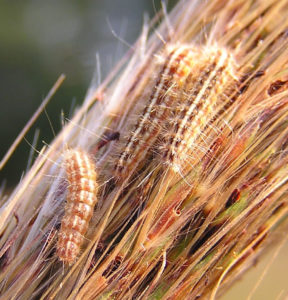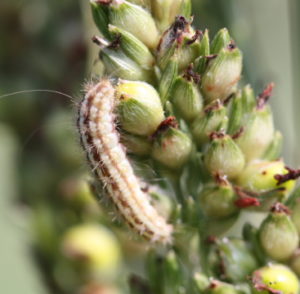According to the responses you entered, this is likely the pest you are dealing with. To confirm this, use the positive identification section.

Photo by Sara Tangren, University of Maryland
Scientific Names
Nola sorghiella
Biology
Adults are small white nocturnal moths. They attach eggs to kernels where they hatch and then begin to feed. Worms damage sorghum by feeding directly on flowering parts and the developing grain, but it is the last two larval instars (growth stages) that cause greatest damage. These worms can go through their complete life cycle in as little as 1 month. Young larvae feed on developing flowers. Older larvae feed on starches in the kernels. In less than 24 hours each caterpillar can eat more than 12 kernels. These caterpillars do not produce webs, but when disturbed they can spin a thin silk thread to allow them to descend to a safer place.
Positive Identification

A sorghum webworm on a sorghum head. Photo from Kansas State Extension.
Larvae are typically a yellowish or greenish brown with red or black stripes down their back. Mature larvae are about 1/2″ long. They are best identified by the presence of many spines and clear white hairs on their body. Many hairs cluster, coming out from a single pore, giving an almost cactus like look to them.
Regional Information
This insect is primarily only found in the eastern half of Texas where it is more humid.
Scouting Tips
When sorghum heads begin to flower you should start to look for sorghum web worms. Scouting is recommended every 5 days until kernels reach the hard dough stage. Using a beat bucket is the best way to look for sorghum webworms. This is done by shaking grains vigorously into a large bucket and then counting larvae.

Sorghum webworm larvae and pupae. Photo by Phil Sloderbeck.
Although we tried to include the most significant pests related to sorghum our tool cannot help you identify every insect found on sorghum. This tool is built to inform you of the most common and significant pests of sorghum in Texas. If the insect you are dealing with does not match the description above then talk to your extension agent or visit this page to look at all the different important potential pests of sorghum. For management information of a specific pest talk to your local extension office.
Image Details:
The second sorghum webworm photo was from Kansas State Extension (http://entomology.k-state.edu/extension/insect-information/crop-pests/sorghum/webworm.html). The original photographer of the photo was unable to be determined by K-State extension personnel.